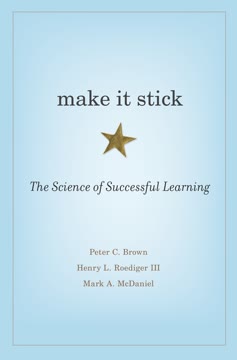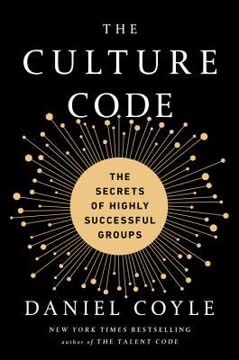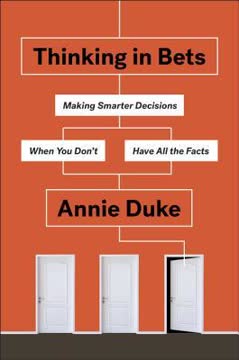Key Takeaways
1. Self 1 vs. Self 2: Understanding the Inner Game
Performance (P) in any activity, from hitting a ball to solving a complex business problem, was equal to one's potential (p) after the interference factor (i) had been subtracted from the equation.
The Inner Game concept revolves around the interplay between two selves within us. Self 1 is the voice of judgment, doubt, and fear, while Self 2 represents our innate capabilities and potential. The key to improved performance lies in reducing Self 1's interference, allowing Self 2 to express itself more fully.
This internal dynamic affects all aspects of our work and life:
- Self 1 tends to overanalyze, criticize, and create self-doubt
- Self 2 is capable of natural, effortless learning and performance
Reducing Self 1 interference leads to:- Improved focus
- Enhanced learning
- Better performance
- Increased enjoyment
2. Focus of Attention: The Key to Superior Performance
Focus is about paying attention while doing whatever you are doing.
Focused attention is the cornerstone of excellence in any activity. It's not about forced concentration, but rather about directing our awareness to the most relevant aspects of our task or environment.
Key aspects of effective focus:
- Nonjudgmental awareness reduces self-interference
- Focus follows interest, not forced effort
- Selecting critical variables helps direct attention effectively
Examples of critical variables:- In tennis: ball trajectory, spin, speed
- In sales: customer interest level, body language
- In management: team dynamics, project timelines
Practicing focus in daily activities can lead to significant improvements in performance, learning, and enjoyment across all areas of work and life.
3. Redefining Work: Performance, Learning, and Enjoyment
Experience itself could be the final authority.
The work triangle presents a new paradigm for understanding and approaching work. Instead of focusing solely on performance, this model emphasizes the equal importance of learning and enjoyment.
Components of the work triangle:
- Performance: Achieving tangible results
- Learning: Developing skills and understanding
- Enjoyment: Finding satisfaction and fulfillment
Benefits of balancing the work triangle:
- Increased motivation and engagement
- Improved long-term performance
- Enhanced personal and professional growth
- Greater job satisfaction and reduced burnout
By consciously attending to all three aspects, individuals can create a more sustainable and rewarding work experience.
4. From Conformity to Mobility: Taking Control of Your Work Life
Mobility is not only change but fulfillment and harmony with one's progress.
Mobility in work refers to the ability to move consciously towards desired goals while maintaining personal fulfillment. It's about breaking free from unconscious conformity and taking charge of one's work life.
Key elements of mobility:
- Grant yourself mobility (acknowledge your inherent ability to change)
- Have a clear picture of your desired destination
- Be willing to make changes within your change
- Keep your purpose clear
- Synchronize your movement and direction
Developing mobility allows individuals to:
- Make more conscious choices about their work and career
- Align personal values with professional goals
- Adapt more effectively to changing work environments
- Experience greater satisfaction and success in their work
5. The STOP Tool: Enhancing Conscious Decision-Making
If you don't have time for STOP, that's when you need it most.
The STOP tool is a powerful technique for breaking out of performance momentum and making more conscious decisions. It stands for:
S - Step back
T - Think
O - Organize your thoughts
P - Proceed
Benefits of using STOP:
- Reduces reactive decision-making
- Enhances strategic thinking
- Improves problem-solving
- Increases awareness of priorities
Situations to use STOP:
- Before starting a new project or task
- When feeling overwhelmed or stressed
- Before important meetings or decisions
- To reflect on progress and lessons learned
Regular use of STOP can lead to more effective work practices, better time management, and increased overall satisfaction with work.
6. Think Like a CEO: Taking Charge of Your Personal Corporation
You are the CEO of an amazing corporation.
Viewing yourself as a CEO of your own life and career can dramatically shift your perspective and approach to work. This mindset encourages taking full responsibility for your choices, development, and outcomes.
Key aspects of thinking like a CEO:
- Recognize your innate resources and capabilities
- Take stock of your "shares" (autonomy in decision-making)
- Define your mission and values
- Make strategic decisions about your "product" (what you offer)
- Invest in your own growth and development
Benefits of adopting a CEO mindset:
- Increased sense of control and autonomy
- More strategic approach to career decisions
- Enhanced self-awareness and personal growth
- Improved ability to align work with personal values and goals
7. Coaching for Mobility: Facilitating Growth and Development
Coaching is the art of creating an environment, through conversation and a way of being, that facilitates the process by which a person can move toward desired goals in a fulfilling manner.
Effective coaching focuses on facilitating mobility rather than solving problems or giving advice. It involves creating an environment that allows individuals to access their own resources and find their own solutions.
Key elements of coaching for mobility:
- Awareness: Helping clients see their current reality clearly
- Choice: Assisting in identifying and evaluating options
- Trust: Building confidence in one's abilities and resources
Coaching techniques:
- Ask powerful questions rather than providing answers
- Use the "transposing" tool to understand different perspectives
- Focus on critical variables to enhance awareness
- Employ the STOP tool to promote conscious decision-making
Benefits of this coaching approach:
- Empowers individuals to find their own solutions
- Enhances self-awareness and learning
- Promotes long-term growth and development
- Improves performance and job satisfaction
Last updated:
FAQ
What's The Inner Game of Work about?
- Focus on Inner Potential: The book explores overcoming internal obstacles to enhance performance and enjoyment at work, emphasizing natural potential for learning and growth.
- Inner Game Concept: It introduces the "Inner Game," focusing on mental and emotional aspects that influence work performance, contrasting with external achievements.
- Self 1 vs. Self 2: Gallwey distinguishes between Self 1 (critical, judgmental) and Self 2 (intuitive, capable), aiming to quiet Self 1 to let Self 2 thrive.
- Learning and Enjoyment: The book advocates for viewing work as a learning experience, where enjoyment is crucial for better performance and engagement.
Why should I read The Inner Game of Work?
- Transformative Insights: It offers a revolutionary perspective on work, challenging conventional beliefs about productivity and success.
- Applicable Techniques: Readers gain practical methods to enhance focus, learning, and enjoyment, relevant for improving professional life.
- Personal Growth: The book promotes self-awareness and personal development, helping individuals navigate careers with confidence and satisfaction.
What are the key takeaways of The Inner Game of Work?
- Overcoming Inner Obstacles: Identifies internal barriers like fear and doubt, providing strategies to overcome them for better work performance.
- Importance of Enjoyment: Emphasizes that enjoyment is critical for work, leading to better performance and engagement.
- Continuous Learning: Advocates for viewing work as a continuous learning process, contributing to personal and professional growth.
What is the Inner Game concept introduced in The Inner Game of Work?
- Inner Game Definition: Refers to mental and emotional aspects of performance, contrasting with the Outer Game focused on external results.
- Self 1 vs. Self 2: Introduces Self 1 (critical) and Self 2 (intuitive), aiming to quiet Self 1 to allow Self 2 to thrive.
- Focus on Awareness: Emphasizes awareness in enhancing performance and enjoyment, encouraging nonjudgmental observation of thoughts and feelings.
How does W. Timothy Gallwey suggest we redefine work in The Inner Game of Work?
- Work as Learning: Encourages viewing work as an opportunity for continuous learning and personal development, enhancing job satisfaction.
- Balancing Aspects: Proposes a model where performance, learning, and enjoyment are interconnected, positively influencing each other.
- Embracing Mobility: Advocates for adaptability and growth, moving away from rigid work definitions and expectations.
How does The Inner Game of Work address the issue of pressure in the workplace?
- Pressure as a Barrier: Discusses how external pressures lead to stress, emphasizing the need to manage them effectively.
- Working Freely: Advocates for a work environment where individuals can work without pressure constraints, fostering creativity and satisfaction.
- Desire Over Pressure: Suggests reconnecting with desires to mitigate pressure effects, as passion-driven motivation reduces overwhelm.
What role does enjoyment play in the workplace according to The Inner Game of Work?
- Intrinsic Motivation: Enjoyment is linked to intrinsic motivation, driving individuals to engage more fully and perform well.
- Counteracting Stress: Fostering enjoyment helps mitigate stress and burnout, creating a healthier work environment.
- Enhancing Relationships: Enjoyment improves colleague relationships, leading to better collaboration and teamwork.
How can I apply the Inner Game principles in my work life?
- Identify Inner Obstacles: Recognize internal barriers like fear or self-doubt, acknowledging them as the first step to overcoming them.
- Practice Focus and Awareness: Engage in exercises enhancing focus on critical work variables, staying present and responsive to challenges.
- Set Learning Goals: Establish learning goals alongside performance objectives, encouraging personal growth and career fulfillment.
What is the concept of Self 1 and Self 2 in The Inner Game of Work?
- Self 1 Defined: Described as the critical, judgmental aspect leading to self-doubt and anxiety, questioning abilities.
- Self 2 Defined: Represents the natural, intuitive self capable of learning and performing without interference, embodying true potential.
- Balancing Both Selves: Achieving balance between Self 1 and Self 2 is essential for optimal performance, accessing Self 2's capabilities.
What are some practical methods to improve focus at work according to The Inner Game of Work?
- Awareness Exercises: Engage in exercises enhancing awareness of critical work variables, helping stay present and focused.
- Setting Learning Goals: Set specific learning goals alongside performance goals, fostering a growth mindset and seeking new skills.
- Nonjudgmental Observation: Practice nonjudgmental awareness, observing thoughts and feelings without criticism, reducing self-interference.
What role does desire play in achieving success according to The Inner Game of Work?
- Desire as Motivation: Portrayed as fundamental motivation behind actions and decisions, driving goal pursuit and obstacle overcoming.
- Connecting with Core Desire: Encourages reconnecting with core desires to fuel ambition and work effectively, essential for fulfillment.
- Ambition and Work: Argues that ambition, fueled by desire, is necessary for significant results, providing motivation to excel.
What are the best quotes from The Inner Game of Work and what do they mean?
- "Man was born free, but everywhere he's in chains.": Highlights constraints in work lives, calling for reexamination of working freely.
- "Awareness itself is curative.": Emphasizes self-awareness's power in overcoming obstacles and enhancing performance through informed choices.
- "The Inner Game is about learning how to learn.": Encapsulates the book's essence, focusing on continuous learning and adaptation in the workplace.
Review Summary
The Inner Game of Work receives mostly positive reviews for its insights on mindfulness, focus, and coaching principles. Readers appreciate Gallwey's approach to redefining work and achieving peak performance through self-awareness and trust. Many find the concepts applicable to various professions, particularly managers and coaches. Some criticize the book for being outdated or overly verbose. Key ideas include the Self 1 vs. Self 2 concept, nonjudgmental awareness, and the performance equation. Overall, readers value the book's perspective on improving work life and personal development.
Similar Books









Download PDF
Download EPUB
.epub digital book format is ideal for reading ebooks on phones, tablets, and e-readers.







